|
Farbio GTS
Debut: 2007
Maker: Farbio
Predecessor: no |
|
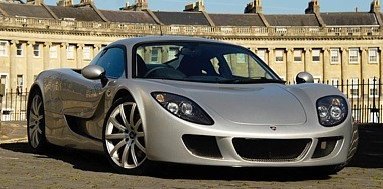
|
Born as a Farboud, finished as a
Farbio...
|
You
might find the Farbio GTS familiar. Yes, about 3 years ago it appeared
as Farboud GTS. It was the brainchild of young British enterpriser
Arash Farboud. Mid-engined, full carbon-fiber body, steel spaceframe
chassis and powered by the old Audi 2.7 bi-turbo V6 engine tuned to 440
horsepower. It sounded promising, but later on Arash Farboud realized
it will never be profitable, thus he sold the project to Chris Marsh.
Marsh had plenty of experience in the sports car industry, as his
father Jem Marsh was the co-founder of Marcos and himself worked at
Marcos for 11 years. To cut the link with the ex-owner, he renamed the
company to Farbio Sports Cars.
The production Farbio GTS keeps the chassis unchanged but switches to a
cheaper engine: Ford's Duratec 3.0 V6. This engine has been used in
many vehicles ranging from Taurus, Mondeo, Jaguar X-Type to Noble M12 /
M400. Farbio gave it bespoke intake and exhaust system to boost its
output to 262 horsepower. From the power and torque curves shown in
Farbio's brochure, we can see the output has 3 peaks, implying it
incorporates a 3-stage variable geometry intake manifolds like the
Jaguar V6. The transversely mounted engine is linked to a 6-speed
manual gearbox. Rear-wheel drive, all double-wishbones suspensions, a
classical sports car layout.
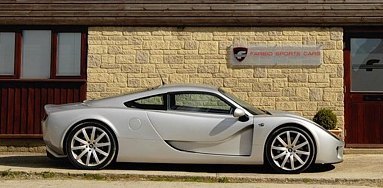
|
It has the visual compactness of
McLaren F1...
|
The exterior design is also a classical mid-engined sports car. It
looks quite like a McLaren F1, thanks to the visual compactness, big
windscreen and cab-forward design. Gordon Murray must have liked its
simplicity. Everything exists because of functions yet the whole car
looks beautiful, if not especially striking. Like the Farboud, the body
shell is fully made of carbon-fiber and bonded to the tubular steel
spaceframe chassis to increase strength. This is the highlight of the
car. Think about it: for £60,000, or the same price as a Porsche
911 Carrera, you get a mid-engined sports car with full carbon-fiber
body. Isn't it a bargain ?
As the car weighs only 1048 kg dry, the modest Ford V6 is powerful
enough to let Farbio claims 160 mph-plus top speed and 0-60 mph in 4.8
seconds, which is about 911 Carrera performance.
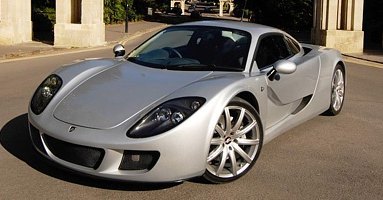
|
Big windscreen and carb-foward design
guarantee excellent visibility
|
The Farbio is also as practical as an everyday car as 911. Its cockpit
is easy to get in and out thanks to large doors and narrow sills. It
accommodates people up to 6' 6". Its 72-liter tank offers good range.
Its 220-liter boot swallows a set of golf clubs and a weekend's
luggage. Its cabin has plenty of standard equipment, such as air con,
power windows, power mirrors, power steering, remote central locking
and heated rear screen. It even offers a touch-screen control with
satellite navigation, radio and Bluetooth at no extra cost. All these
features can't be said to other British sports cars like Lotus, TVR and
Noble. Of course, build quality is no match with Porsche, but this is a
common problem of low volume sports car makers.
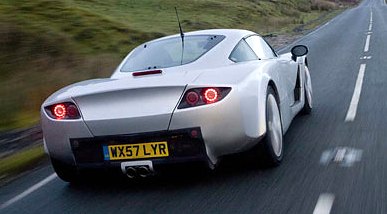
|
The Ford Duratec V6 is not a
thoroughbred sports car engine, so it needs a lightweight carbon-fiber
body to deliver performance.
|
On the
road,
the Farbio feels initiative. You sit low in the Sparco bucket seat and
enjoy excellent view all-round. The clutch is light and smooth. The
steering is direct and communicative. The gearchange is short and
positive. All controls are well tuned. The engine sounds better than
the usual Ford unit thanks to the new intake and exhaust, though not as
musical as a Porsche or M3. It isn't massively powerful, but thanks to
the lightweight the GTS feels brisk enough to believe its claimed
performance.
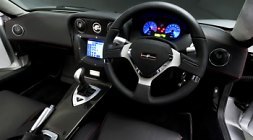
|
Carbon-fbier inserts, Alcantara
trimming and touch-screen control are the highlights of the cabin
|
Its
suspension
setting is a work of art. No matter low speed or high speed it rides
very well. The combination of wide tracks and low center of gravity
means it doesn't need German-stiff suspension to contain body roll. The
chassis dynamics is near neutral. With just 39 percent weight over the
front wheels, it turns into corner responsively yet without displaying
a tendency to slide its tail. The latter is due to the grippy
285/35ZR19 rear tires. Admittedly, the Ford V6 does not have enough
torque to upset the massive rear tires on dry surface.
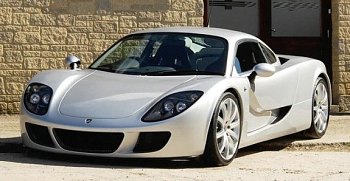 |
In many ways it feels like a slightly
faster and sharper Porsche Cayman S
|
Surprisingly,
the GTS is a good companion for long-distance traveling. Its
full-length flat undertray and venturi tunnel guarantee excellent
stability on highway. Its oversized AP brakes with four-pot calipers,
350mm front and 328mm rear ventilated discs provide great stopping
power. In addition to the supple ride and aforementioned practical
features, no other British sports cars are so close to the territory of
Porsche - with the exception of Aston Martin of course.
In many ways the Farbio GTS feels like a slightly faster and sharper
Porsche Cayman S. However, before you choose it over the Porsche you
have to think again whether you can accept its unremarkable Ford
engine, its lack of ESP or limited-slip differential (which could be a
problem on wet) and its questionable build quality and reliability. If
you can, you will get one of the 150 cars Farbio plans to produce this
year. Next stage will be a 384-horsepower supercharged version, priced
at £72,000 to rival 911 Carrera S. Following the demise of TVR
and the prolonged delay of Noble M15, I sincerely hope Farbio will
succeed.
|
| The
above report was last updated on 24 Feb 2008. All Rights Reserved. |
|
GTS350 and GTS400
|
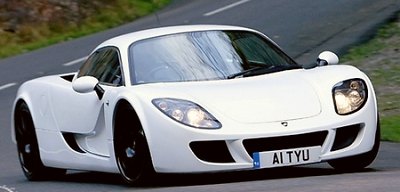
|
A true sports car as well as a good
everyday tourer. Has 911 Turbo ever been so good ?
|
Farbio
launched its naturally-aspirated GTS in early 2008. It won overwhelming
acclaims from British and European press thanks to its outstanding
handling and surprising usability. However, the £60,000 GTS is
unlikely to be a cash cow – think about that expensive carbon-fiber
body and the low volume production. Therefore, by the end of 2008,
Farbio introduced two more derivatives – GTS350 and GTS400. Both employ
supercharging to enhance performance and make possible for higher
profit margins. The GTS350 provides 350 horsepower at £78,000,
same money as a 911 GT3. The range-topping GTS400 boosts 410 horsepower
and demands some £94,000, right at the territory of 911 Turbo.
Are they good enough to ask for so much ?
The answer depends on your viewpoint. If you count the changes they
made from the base car, you may find them hardly worth the premium. The
GTS350 is basically a GTS with a Rotrex supercharger and charger cooler
bolted on. According to Farbio, this shortens 0-60 mph sprint from 4.8
to 4 seconds flat and lifts top speed from 160 to 175 mph. The rest of
the car is unchanged. Not just the chassis and body, but also gearbox,
suspensions, tires, wheels and brakes. We used to wonder why the
standard GTS needed those oversized tires, wheels and brakes and all
those over-specced chassis parts to take on its modest power. Now we
understand why.
GTS400 is a little better. To cope with the higher boost Rotrex
supercharger, its engine gets stronger connecting rods and pistons.
Besides, the original 19-inch alloy wheels are replaced with 20-inch
carbon-fiber wheels, which cost an eye-popping £6,000 but weigh
less than half of the original items. This explain why the GTS400
weighs only 1046 kg, 20 kg less than GTS350 and even slightly less than
the base model. However, excluding the carbon wheels from its price and
you will find the supercharger kits alone costs as much as
£28,000 ! Crazy.
Nevertheless, your conclusion may be changed once you have driven the
machines, especially GTS400. In the past, the naturally aspirated car
begs for power to exploit its deep reserves of handling prowess. Now
GTS400 is the answer. Initially, you might find its progress a little
disappointing. Performance is brisk rather than explosive, and its
briskness is mostly down to its lightweight. Below 4000 rpm, the engine
feels nothing special, not noticeably more powerful than the naturally
aspirated unit. This is because the centrifugal type Rotrex
supercharger works best at high rev. Up to 4000 rpm, its boost pressure
is no more than 0.4 bar, lighter than most light-pressure turbos on
family cars. Full boost of 0.85 bar is not available until about 6000
rpm, by then it becomes really FAST. Unfortunately, you will have a
narrow window of 1000 rpm or so to play with its full strength. Such a
peaky manner is similar to Koenigsegg supercar, which also employs
Rotrex supercharger.
Using centrifugal type supercharger has two advantages. Firstly, the
engine does not need heavy modifications - even compression ratio can
be maintained. Secondly, it is more energy efficient at high rpm. This
can be seen in the fact that GTS400 produces 137 horsepower per liter,
matching the specific output of turbocharging but without its
complication. This could be very attractive to a budget-limited small
company like Farbio.
Of course, the downside is that you need to rev its engine hard in
order to feel its true power. However, this is actually very
entertaining. The Farbio encourages hardworking. Floor down the
throttle, hear the thundering exhaust note, see its needle kiss the
7000 rpm redline, follow by a clean upshift and another round of
acceleration… If the surface is grippy enough, you just might match the
company's claim of 3.7 seconds from 0-60 mph. Flat out, it will top a
respectable 185 mph. If not exactly matching 911 Turbo, it won't be far
off.
As the chassis and weight is virtually identical to the standard GTS,
its handling and ride remains exceptional. It always feels light and
agile, with a direct and communicative steering, neutral attitude,
rock-steady cornering and a supple ride no matter on A or B roads. When exiting corner, apply
too much throttle will not unsettle its tail like 911, as the peaky
engine does not have enough torque to slide the grippy rear rubbers. It
is a true sports car as well as a good everyday tourer. Has 911 Turbo
ever been so good ? I doubt.
We said GTS is very well equipped. The same applies for GTS350 and
GTS400. You get air con, power windows, power steering, traction
control, bluetooth, a nice touch screen sat nav, an accommodative cabin
and a useful boot. Build quality seems better controlled than the late
TVR, Noble or Marcos, with tight shut lines between carbon-fiber body
panels and decent finish of interior trimming, although it's not
comparable to the mass production Porsche. Durability, reliability and
maintenance remain a question. As is long term servicing for a company
without track records. That is a gamble you must take if you opt for a
rarer, British-built alternative to 911 Turbo.
|
| The
above report was last updated on 22 Sep 2009. All Rights Reserved. |
|
|









